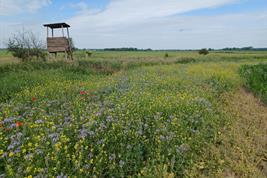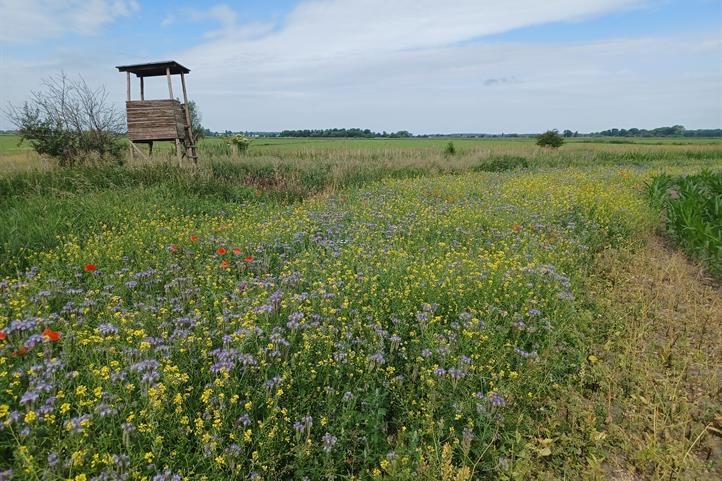21.07.2022
Press Release

In the "FInAL" project, researchers from the Leibniz Centre for Agricultural Landscape Research (ZALF) are testing measures for insect protection. Since 2018, they have been investigating possibilities for the insect-friendly management of lowland fen soils in a specially established landscape laboratory in Havelland, Brandenburg. These soils can only be used to a limited extent for agriculture, but are very valuable due to their ecological significance, for example as carbon sinks. By directly comparing areas with and without measures, practical results are now available showing the successes and limitations of various insect protection measures.
According to the latest report by the Intergovernmental Science-Policy Platform on Biodiversity and Ecosystem Services (IPBES), biodiversity loss is a threat to billions of people. At the latest since the publication of the "Krefeld Study" in 2017, the decline in insects has also been a cause for concern in Germany. A research team is combining insect protection with the cultivation of renewable raw materials on test sites at the Leibniz Centre for Agricultural Landscape Research (ZALF) in Havelland. Coordinated by the Thünen Institute, insect-friendly agriculture has been tested in practice here since October 2018 as part of the research project "FInAL - Facilitating Insects in Agricultural Landscapes" in a landscape laboratory in lowland fen areas. The lowland fen areas were drained and intensively used for agriculture until 1992. Since then, they have been under protection. The researchers have investigated how these areas can now be managed in a way that is friendly to both insects and the environment, and at the same time economically viable.
Results are now available showing that proper tillage is crucial for the occurrence of wildflowers and insects in grassland. Beetle banks also contribute to insect diversity in agricultural landscapes. The question of how insect protection measures are perceived by practitioners and the public also plays an important role.
Insect-promoting measures tested
Wildflowers in grassland are an important food source for insects. However, for wildflowers to establish successfully, the soil must first be tilled or mulched to loosen the turf – this is the result of the project's initial research findings. The research team was also able to demonstrate the effectiveness of beetle banks, i.e. retreats for insects at the edges of fields, in promoting ground beetles. Ground beetles are beneficial insects in agriculture because they feed on various pests, such as snail eggs. The researchers counted almost eight times more ground beetles on the area with beetle banks than on the reference area without measures. The effect on spiders and rove beetles, on the other hand, was small to non-existent. This is also an important finding for the research project and the selection of measures on other farms. "What is special about the project is the research approach, in which we involve many important relevant stakeholders in the research from the very beginning and test insect protection measures under practical conditions and in direct comparison with a reference area," says Prof. Frank Eulenstein, who is coordinating the project on the ZALF side.
Economic solutions for insect protection
The studies show that two factors must be met in order for measures to be successful: they must be economical and they must take local conditions into account. "There is no set of blanket measures for insect protection. This varies greatly from farm to farm and makes it difficult to implement measures on a broad scale. That's why we need these practical trials in as many different regions as possible", adds Eulenstein. The experimental plots on which the ZALF researchers conducted their trials are located in the Havelländische Luch, a lowland fen area in Brandenburg. Lowland fens are characterized by a high content of organic matter. If the land is drained for agriculture, as is the case here, large amounts of carbon dioxide are released, which contributes to climate change. However, there is a lack of water in the region for the rewetting of the areas in the Havelländisches Luch. In order to be able to use the land in an environmentally friendly and economical way, the grassland there is now used three times, a so-called "cascade use": By sowing wildflowers, the food supply for insects is increased on the land. The biomass produced on the land can be used by the farms in biogas plants. The residues from the energy production, in turn, are suitable as peat substitutes. Since peat is to be largely replaced in commercial horticulture by 2030 and banned in recreational horticulture by 2026, peat substitutes are becoming increasingly important right now. Thus, an insect-friendly and economical management system was tested specifically for lowland fen soils. Other landscape laboratories in the project are located in Lower Saxony and Bavaria, where research has been conducted since 2020 on insect protection measures adapted to the respective context and local conditions.
Cooperation with farmers, but also with local communities as well as soil and water associations, plays a major role in the development of measures. The researchers specifically investigated farmers' perceptions of the ecological importance of insects and their decline. The majority were receptive to insect protection measures if they were financially compensated for them. To ensure that insect protection measures are also supported by the wider public, the researchers provide information at meetings and through information boards in the fields.
Project partners:
- Thünen Institute of Biodiversity (Coordination)
- Leibniz Centre for Agricultural Landscape Research (ZALF)
- Thünen Institute of Farm Economics
- Julius Kühn Institute
- Lower Saxony Chamber of Agriculture
- Bavarian State Research Center for Agriculture (LfL)
Funding:
FInAL is funded by the FNR (Agency for Renewable Resources), a project sponsor of the German Federal Ministry of Food and Agriculture.
 Press Release as PDF file
Press Release as PDF file
Further information:
Pictures
For downloading the pictures please click on a picture and use the icon.


In Havelland, insect protection measures are being tested in a living laboratory, such as the cultivation of flowers in grassland. | Source: © Philipp Scharschmidt / ZALF.
